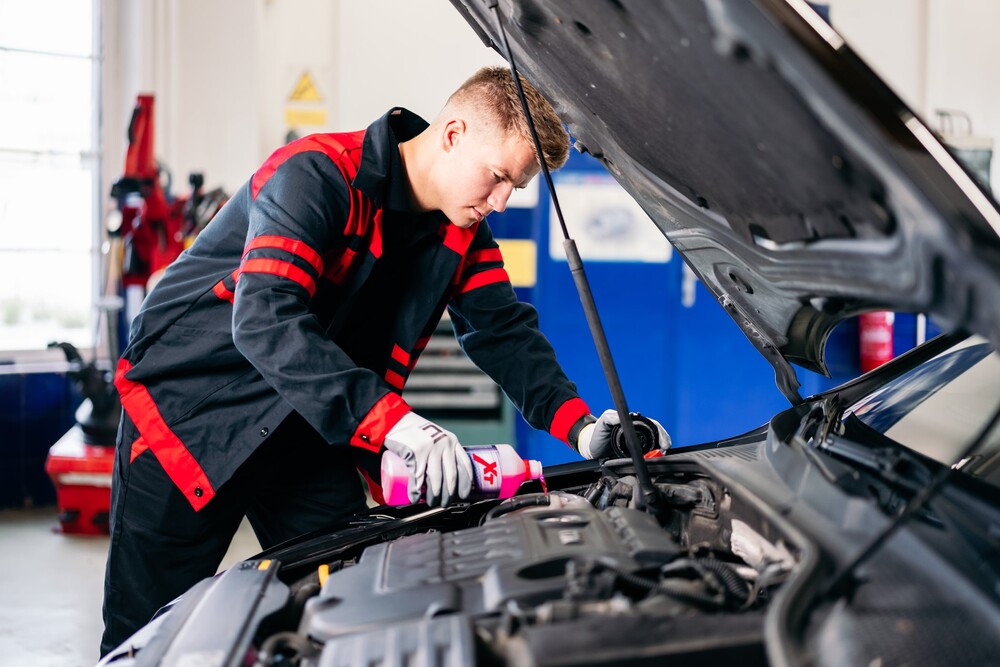What does coolant contain?
The coolant is a combination of antifreeze and distilled water, the task of which is to remove heat from the engine to the cooling system. Antifreeze usually contains the chemical compound ethylene glycol or propylene glycol, which lowers the freezing point of the liquid. They thus prevent the coolant from freezing at very low temperatures. Coolant mixtures typically have a freezing point of approximately -15°C to -35°C.
Key functions of coolant
Correctly selected coolant ensures problem-free and safe driving even in severe frosts and extends the life of the engine. Here are its benefits:
- Engine cooling. The primary function of the coolant is to absorb the heat generated when fuel is burned and conduct it away from the engine to the radiator, where the heat is released into the surrounding air. This helps keep the engine at optimum operating temperature.
- Protection against corrosion and deposits. The coolant contains corrosion inhibitors that protect the internal metal parts of the engine and cooling system from corrosion. This prevents damage to the engine, radiator, hoses and other components. It also prevents the formation of deposits that could restrict the flow of coolant and reduce the efficiency of the cooling system.
- Protection against overheating. The coolant mixture has a higher boiling point than pure water. This is especially important in hot weather or when the engine is under heavy load, when the engine temperature can rise significantly. For example, a mixture of 50% water and 50% ethylene glycol may have a boiling point of around 107-110°C at normal pressure.
- Protection against freezing. The coolant contains an antifreeze component that lowers the freezing point of the liquid. This prevents the liquid from freezing in the cooling system at low temperatures, which could lead to cracking of the engine block or other components.
- Water pump lubrication. Coolant helps lubricate water pump seals and bearings, reducing friction and wear. A properly lubricated pump ensures efficient fluid circulation throughout the system.
Measuring the freezing point of the cooling liquid
Not sure what the freezing point of your coolant is? You can check it before the winter season. A special refractometer will provide accurate information. It shows at what temperature the liquid freezes. The freezing point can also be measured with a hydrometer, which measures the density of the cooling liquid. The measured value can be indirectly used to estimate the concentration of glycol in the liquid, and therefore also the freezing point. Measuring with a densitometer is fast and simple, but less accurate than with a refractometer.
While a refractometer uses the optical principle of light refraction, a hydrometer relies on the physical principle of buoyancy in a liquid.
 Image by Freepik
Image by Freepik
Coolant warning light
What to do if your coolant light comes on on your dashboard? It is important to react immediately and check the coolant, as this may signal a problem with the cooling system and cause subsequent engine overheating.
- Stop the vehicle in a suitable place. Do not continue driving if possible, as continuing to drive could cause the engine to overheat.
- Allow the engine to cool for at least 15-30 minutes. The engine and coolant can be very hot, and opening the radiator or expansion tank immediately after stopping could cause hot fluid to splash out and cause burns.
- Check the coolant level. After the engine has cooled, open the hood and check the coolant level in the expansion tank. If the level is low, this could be the cause of the light coming on.
- Add coolant if necessary. If the coolant level is low, you can top it up. Use the correct type of coolant recommended by the vehicle manufacturer. If you don't have it on hand and it's not below zero outside, you can use distilled water as an emergency because it does not contain limescale. However, use this only for emergency touch-up, then drain it as soon as possible and replace it with standard coolant.
- Start the engine and check the warning light. After topping up the fluid, start the engine and see if the coolant light comes back on. If the warning light goes out and the engine is operating normally, you can safely continue driving. If the light is still on after adding fluid, it could indicate a more serious problem, such as a faulty thermostat, water pump, or other mechanical failure in the cooling system.
Tips from TASY specialists
Even if your coolant light goes out after topping it up, it is better to visit a specialized car service. Here at TASY, we can, among other things, check the entire cooling system and reveal the cause of the problems. We can also recommend the appropriate type of coolant for your car and measure the freezing point of the fluid.
Also visit a garage if you notice a coolant leak or oil in the coolant. Leaking coolant can indicate burst hoses, leaking joints, a damaged radiator, faulty gaskets, or other mechanical failure. Oil in the coolant is a more serious problem and usually indicates a cracked head gasket, cracks in the cylinder head or in the engine block.
Coolant replacement vs. topping up the coolant
The recommended coolant change/replenishment interval depends on the type of coolant and the vehicle manufacturer's specifications, but in general:
- Traditional (older) coolants: Recommended replacement every 2-3 years or after 30,000 to 50,000 km.
- Modern coolants (long life): Some newer types can last 5 years or up to 150,000 km before needing replacement.
When is it possible to choose to top up the cooling liquid?
Topping up the cooling liquid is suitable when its level has dropped slightly and at the same time it is in good condition. This means that the existing fluid is clean, with no visible deposits, discoloration or odor. Add coolant of the same color as you see in the reservoir. Never mix liquids of different colors, this could cause serious problems.
When is it appropriate to change the coolant?
If the coolant is older, cloudy, contains deposits, or has an unpleasant odor, it is better to replace it. These symptoms indicate that the liquid has lost its protective properties and may be ineffective. Start the coolant change by draining the old coolant. Always drain with a cold engine to avoid burning yourself with hot coolant.
Final tip: Check the coolant level regularly
By checking the level and condition of the coolant from time to time, you can prevent various problems such as coolant leakage or oil in the coolant. By checking, you ensure optimal protection of the engine and a long service life of the cooling system.
In our TASY car service, we will be happy to help you not only with everything related to coolant, but also with filling the air conditioning or adjusting wheels of the car.
Read also why it is important to change the engine oil regularly or when it is appropriate to renovate the headlights.

